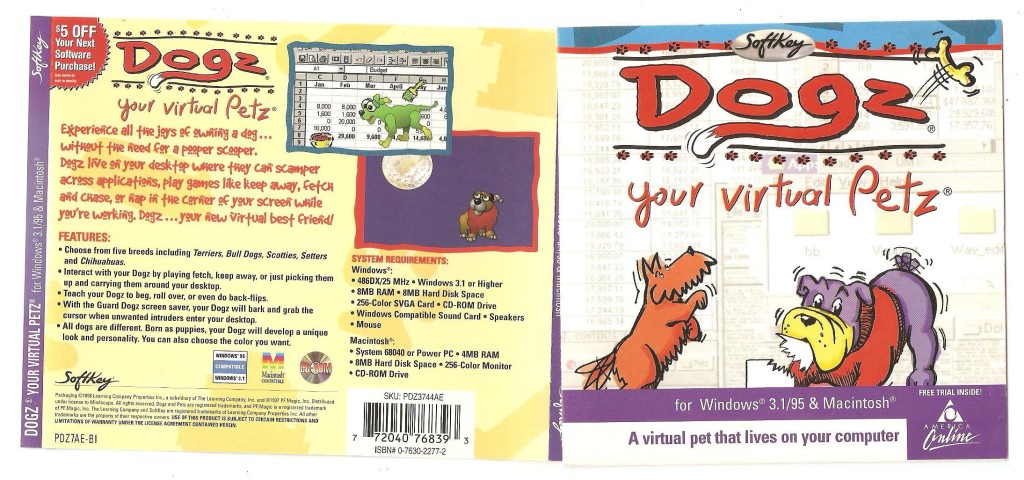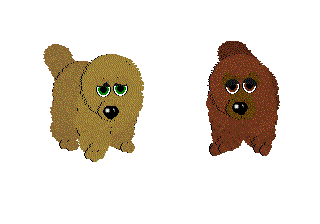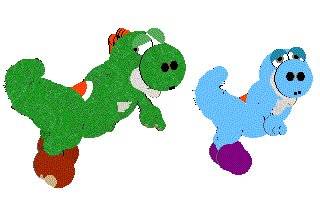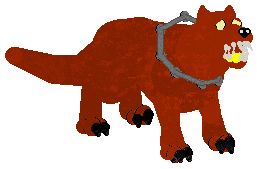The year was 1995. A company called PF Magic (said to have stood for “pure f–ing magic”) released a virtual dog simulator for Windows PCs called “Dogz.” I was 8 years old, and had just taken a serious interest in computers (beyond just roaming around the AOL portal and playing game demos, that is). My first encounter with Dogz was actually with the Mac version that came out in 1996. My best friend who lived conveniently across the street from me had it on her family’s computer and it blew. my. mind.
The first version was simple: you could choose from 5 breeds: Scottie, Chihuahua, Bulldog, Setter and Terrier––which was different from Scottie even though Scotties are, in fact, terriers. Your virtual dog existed in a “playpen” which you could customize by selecting one of several very Windows 3.1-like background patterns. Alternatively, you could let your dog roam around your entire desktop, which was like, you know, crazy cool. There was a ball you could throw, a paintbrush so you could paint your dog a different color (what?), food and water dishes, and a few other things like maybe a sneaker? I can’t remember. Anyway, it wound up gaining quite a following and it wasn’t long before a network of online kennel clubs (“Petz rings”…remember webrings? much nostalgia. such gifs) and Petz contests sprung up and people realized that it actually wasn’t that hard to mod the game.
Except that Petz modding (I say “Petz” because by now, PF Magic had begun to expand with Oddballz and Catz) was never called “modding.” It was called hexing, because in the beginning, you had to edit a bunch of hexidecimal code in order to do it. As it turned out, Petz breedz were created from “ballz” and “linez” and all one had to do in order to create a new breed was modify their size, position and color. Of course, it wasn’t entirely that simple and thus hexing grew into an odd sort of art form, where those who were truly excellent at it were elevated to god-like status in the fandom. Most of the Petz websites from that era were hosted on Angelfire and Geocities and are now lost to time, however, a few remain as a testament to the weird, awesome culture of Petz hexing.
Fortunately, one of those is Carolyn’s Creations, which was like, one of the sites to go to for new Petz breedz. Stop for a moment and click on that link––it’s magnificent. You can even choose between frames and no frames (hashtag frames5ever). Carolyn was one of those fandom superstars, and I remember visiting her site to learn how to hex, though I was never successful at it. Carolyn’s breedz ranged from relatively normal variants such as Chow Chows…
…to this incredibly complex Yoshi recreation:
Another incredibly-prolific hexing hero was Supernova (real name Jessica). I mean, just check out this list of breedz…it’s insane. Also, check out this tutorial for a little insight into how hexing was done in the early days, before programs like LNZ Pro were developed to make it easier.
I think one of things that makes Petz hexing worth talking about is that the whole community was comprised largely of women. Women talked about the game, women modded the game, and women built websites about the game. It was a fun, friendly, amazing community to engage with and I honestly haven’t seen anything like it since. In the Petz community, women took a game marketed to them with cute puppies and kittens and modded it to create freaking hellhounds. I feel like there’s a message somewhere in there for game developers today, how about you?



